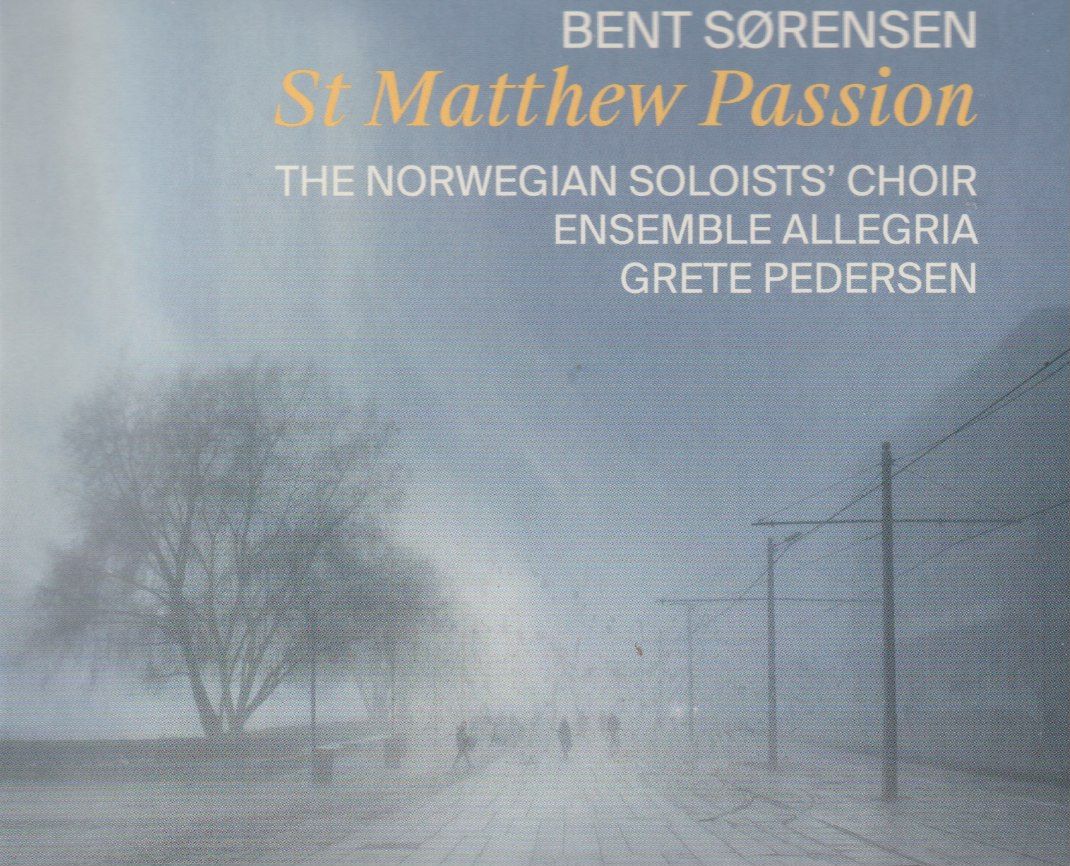Bent Sørensen’s stunning St Matthew Passion
An astonishingly powerful modern-day St Matthew; and the perfect complement to JSB’s towering masterpiece

Written in 2019, Ben Sørensen’s St Matthew Passion sets texts by a variety of authors: Edith Södergren, Anna Akhmatova, Emily Dickinson, Søren Ulrik Thomsen, Ole Sarvig and Frank Jãger, as well as tracts from the Bible.
The booklet note is written by the composer himself. His statement about why he wrote a St Matthew Passion is really quite arresting:
When you reach a certain age, you become aware, as a composer, that you will not be able to compose at all, that here is a limit. So, without telling anyone ... I decided that everything I was going to compose from then on was going to lead me to a St Matthew Passion.
Co-commissioned by the Oslo International Church Music Festival and the Danish National Symphony Orchestra, the final work was started in 2018. The text was created by Sven-David Sandström, who had previously worked with Sørensen on teh composer’s St John Passion.
Sœrensen’s St Matthew traces a “journey in the mist - in and out of the light. A journey towards crucifixion, but even more a journey towards resurrection.” The music also reflects the passion “we feel for the people we love”.
Sørensen’s journey to the cross is not a linear one - he gives the impression of looking askance, fragments of texts appearing “like graffiti on buildings”. It is almost as if Sørensen crosses a Passion with his own Winterreise. Indeed, the final words of the piece, “the sound of my footsteps goes on into the mist,” seem to echo the eternal trudge of Schubert’s wanderer.
Sørensen acknowledges Bach’s St Matthew Passion lying behind the work, but only integrates one quote (Bach’s melody is "behind" Sørensen’s at “My God, my God, why hast thou forsaken me?”).
The composer could surely not ask for a better performance than this. In terms of sheer vocal control, try the final minutes of “Wild Nights,” the fourth movement (two texts are set here - first Emily Dickinson, then a tract from Isiah (“Fear not, for I have redeemed thee”)
In accordance with the idea of the mists, the piece actially begins with a movement entitled “In the veil of mist,” setting texts by Thomsen (Shaken Mirror), Akhmatova (Requiem, Rosary, At the Edge of the Sea), Södergren (The September Lyre), St Matthew (“You are salt in the earth ...”) and the Psalms (Miserere nostri Domine. Orchestral sounds seem to slide in and out of focus; this is music is haunting in extremis.
As Andrew Mellor in his book The Northern Silence says,
Silence is the aesthetic basis for most of Sørensen's works, the 'white wall' that becomes increasingly dominat as his narratives dissolve or, occasionally, resolve (The Northern Silence: Journeys in Nordic Music and Culture, Yale University Press, 2022, p. 176)
The second movement, “Betania,” seems to hover just above silence, another tapestry of authors. The sheet control of The Norwegian Soloists’ Choir is remarkable:
Only in the third movement do we have one main “author” (Psalms 23:2 and 23:5), plus two lines by Thomsen (“You are the inmost part ofthe palm / I overflow with silence”) . Even the trumpet fanfares that punctuate, garland the opening of this movement seem somehow recessed. Sørensen’s harmonies seem to become more self-consciously beautiful here (and listen to the purity of the choir’s sopranos in this movement!) and the arrival of a chorale-like melody towards the end, restrained on muted trumpet, is massively affecting:
Conductor Grete Pedersen seems to find the perfect tempos throughout. The shifting of the opening of “Wild Nights” (the entire movement is quoted above) are perfectly judged; later, shifting, choral textures remind me of snow drifting in the wind. Absolutely magical.
The “Cricifixus,” a mix in Sørensen of Akhmatova, Dickinson and the Nicene creed (this last sung in Latin), is hauntingly encrusted with pealing bells. Akhmatova”s words cut deep (“They led you away at dawn / I followed you like a mourner / The deathly sweat on your brow”):
The sheer painful beauty of the “Crucifixus” surely elevates Sørensen’s achievement to that of the great Passions (yes, including the Bach St Matthew Passion, which Sørensen refers to as “maybe the greatest work of art in any genre ever to be created in our culture”). A bell tolls again in “Lament” (Ditte Marie Bræn is the soprano soloist). The text sis predominantly Akhmatova, with excerpts from St Matthew and St John, although teh opening couplet is from Södergren’s Farewell:
The first lines of “Tenebræ” say it all: “from the sixth hour / there was darkness over all the land” (St Matthew). Sørensen’s music certainly reflects this. Listen, too, to the skill with which Sørensen plays with the timbral intersection of instrumental and vocal sounds:
It is good, surely, that the Divine Feminine gets the a word. The eighth movement is entitled, “Magdalena,” and features tenor Øystein Stensheim:
Parts of the harmonic language of this music strike me as Bergian; at other times, Schoenberg seems to hover. The ninth movement, “The shore again, Galilee” begins with the most remarkable sounds, pure Sørensen. Only two lines are set here: “And look, I am with you always, yes, to the end of time” (Matthew) and “I am the one you love and will always love” (Södergren):
The tenth and final movement reflects the first in its title, “Into the Mist’. No fewer than seven authors (f we include the anonymous Liturgy of Tenebræ as an author) are set here. The final lines seem to reflect Schubert’s “Der Leiermann” (Winterreise), but maybe the most touching are Akhmatova’s, from her Requiem:
In the dense mist, the Northern Star - in brightness,
And a blue shine of the beloved eyes
Is covered by the last fear-darkness ...
Astonishing words, and astonishing music, often tissue-thin in its scoring.
An remarkably powerful, modern-day St Matthew; and the perfect complement, I would suggest, to JSB’s towering masterpiece.
